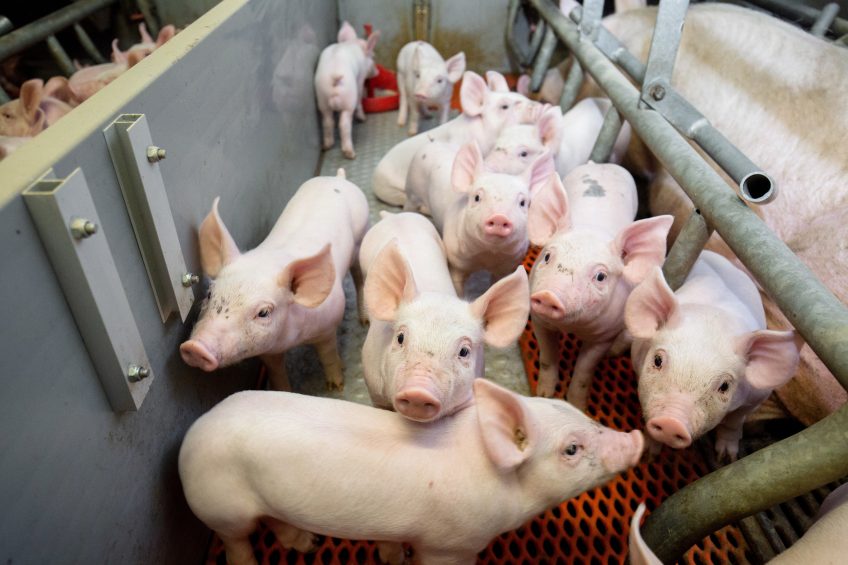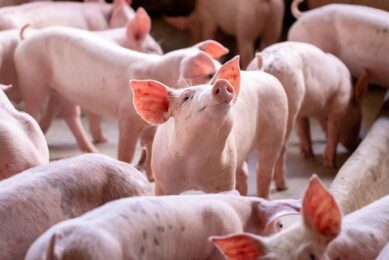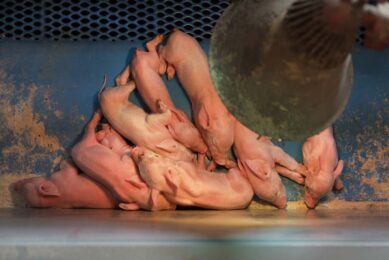Effects for pigs from newly designed yeast derivatives

Often, yeast derivatives in pig nutrition are by-products from other industries. Now what if a purpose-made yeast derivative would be created for animal production? This focus led to the development of a feed additive blending specifically selected strains together.
Yeast derivatives (inactivated whole yeasts or yeast cell walls) are well known for their benefits in animal and human nutrition and are mainly used to:
• Help balance the intestinal microflora;
• Help stimulate the host natural defences.
Most yeast derivatives on the market are by-products of the fermentation industry, so they are not primarily produced for this purpose. They are usually characterised according to their biochemical composition: levels of mannan-oligosaccharides, yeast β-glucans or protein contents. If such approach is interesting to evaluate product purity, it does not reflect totally their functionality, for example their ability to bind to pathogens or stimulate immune pathways in the host.
A deeper dive into yeast
Using novel techniques such as atomic-force microscopy (AFM) and single-molecule force spectroscopy (SMFS), the team was able to ‘visualise’ the yeast surface topography in terms of pathogen binding potential. Binding molecules were shown to be arranged differently depending on the yeast sample. For certain yeast strains, they are arranged as ‘sticky patches’, while in others, they are scattered along the surface. In terms of functionality, the sticky patches showed higher adhesive properties. This finding showed that, while biochemical parameters are important, they are not sufficient to account for the functionality of a given yeast fraction. The distribution of these molecules along the cell wall is also very important. The studies demonstrated that yeast strains do not all share the same biophysical structure, or ‘topography’.
Using SMFS it was possible to measure the length of the polysaccharides chain: a characteristic linked to the binding capacity. These findings also unveiled differences between yeast strains. Thus, yeast cell wall properties are linked to the strain, each strain exhibiting specific structure and functionality in terms of binding properties. Based on this knowledge, single-molecule techniques were applied to screen different yeast strains and select the best candidates for optimal pathogen binding potential.
Importance of the production process
Another lesson learned from this research is that, for a given strain, binding properties can differ according to the production and inactivation process involved. Hence, for every selected strain, it is essential to determine the optimal production conditions: fermentation, but also the treatment of the live yeast to obtain the yeast fractions (inactivation technique). This cannot be controlled when yeast cell walls are the by-product of fermentation processes, since in this case the industrial processes are designed according to the primary production. When producing custom yeast cells, however, the production process for each strain can be adapted to reach the desired characteristics of the yeast derivative.
Different strains from 2 different yeast species (Saccharomyces cerevisiae and Cyberlindnera jadinii) were selected for their complementary properties. For each strain, an optimal production process was developed. Once an optimal formulation was designed based on in vitro studies, it was time to validate the model in vivo. A trial was performed to evaluate the aptitude of our new yeast derivatives product to mitigate pathogens presence in the intestinal tract of piglets. This study showed a significant reduction of E. coli contamination in faeces after a pathogen challenge, see also Figure 1.
Figure 1- Effect of new yeast derivative formula on faecal E. coli excretion in challenged piglets.

Immune modulation
The selected yeast strains were also tested in vitro for their effects on the immune response. Certain parts of yeast cell walls are recognised by immune cells receptors. This interaction is known to stimulate immune reaction in the mucosa of the digestive tract. The most widely described and studied immune receptor is Dectin-1.
The study enabled to evaluate the level of immune stimulation, using human immune cells (monocytes). Activation was measured as the production of reactive oxygen species (ROS) by these cells. When testing the individual yeast strains in vitro, they showed different levels of immune stimulation. Moreover, when mixed, the effects were not only additive, but a synergistic effect was also observed (Figure 2).
Figure 2 – Production of reactive oxygen species (ROS) by immune system cells incubated with different strains of yeast.

In addition, tests were performed using Dectin-1 antagonists. The results showed that Dectin-1 receptor was involved in the response, but that it was not the only pathway involved in the immune stimulation: the Cyberlindnera jadinii strain used other types of receptors as their action was not inhibited when Dectin-1 receptor was blocked. This can explain the synergistic activity of both yeast types. Instead of over-stimulating Dectin-1 receptor, the association of the different yeast strains offers a multi-pathway stimulation. The findings open up new possibilities and show that formulating yeast cell walls is a complex task but a promising approach to optimise their benefits. To date, a patent has been filed concerning the synergistic effect of the yeast extract combination on the immune system.
These immune properties are also evidenced in vivo. When it comes to immunity and inflammation, it is all about balance. The objective is to maintain a delicate equilibrium between anti- and pro-inflammatory mediators.
Application in piglets
Based on this scientific approach, a specific yeast derivative formula was developed and is now marketed (trade name: ‘Yang’, short for Yeast Association New Generation). It can be used in all animal species. Trials performed in different species have shown that this formula is effective in helping animals face stresses, such as pathogen pressure, weaning or feed transition in a context of lower antibiotic usage.
In piglets in particular, it is established that weaning is a stressful event for the digestive system, while their performance right after weaning is critical for the subsequent growth. Apart from that, there is a huge risk of intestinal colonisation of, among others, enterotoxigenic strains of Escherichia coli, the agent enteric of colibacillosis.
A commercial trial was conducted at a French farm in 2014 in post-weaning piglets. The trial itself was conducted in the starter phase, comparing a control group vs. a supplemented group, but under two different approaches. During the prestarter phase, all piglets in the trial had received either a non-supplemented feed or a feed including the yeast derivatives. When the product was only applied in the starter feed, the Average Daily Gain (ADG) of the supplemented piglets showed an increase of 33.54% vs. non supplemented piglets.
When the trial was done after the supplementation in the prestarter feed, the performance of the control group was much higher than with the previous approach, showing an effect of the product in the starter phase, while the addition of the yeast derivatives in the starter feed further increased ADG by 4.5%, see Figure 3.
Figure 3 – The application of the combined yeast strategy* in prestarter feed also supports the performance of starter feed. Figure shows Average Daily Gain in starter pigs (kg/d).

Benefits in post-weaning piglets
Another zootechnical trial conducted at a commercial farm in Hungary in 2015 confirms such benefits in post-weaning piglets. Benefits particularly were seen in a context of antimicrobial withdrawal in feed. Those benefits were reflected by an increased Average Daily Gain of 4.7% (+21 g/d) during the whole post-weaning period, and a reduction of Feed Conversion Ratio of 4.3% during the starter phase, just after the removal of zinc oxide in both control and supplemented groups.
In conclusion, the use of an original, single-molecule microscopic-based approach to yeast strain selection and yeast derivatives development has led to new generation of yeast derivatives, with promising applications at a time when increased pressure is put on the industry to reduce the use of antibiotics in piglet feeds, especially immediately after weaning, when the challenge of diarrhoea due to colibacillosis is at its highest.
Join 18,000+ subscribers
Subscribe to our newsletter to stay updated about all the need-to-know content in the pigsector, three times a week. Beheer
Beheer










 WP Admin
WP Admin  Bewerk bericht
Bewerk bericht